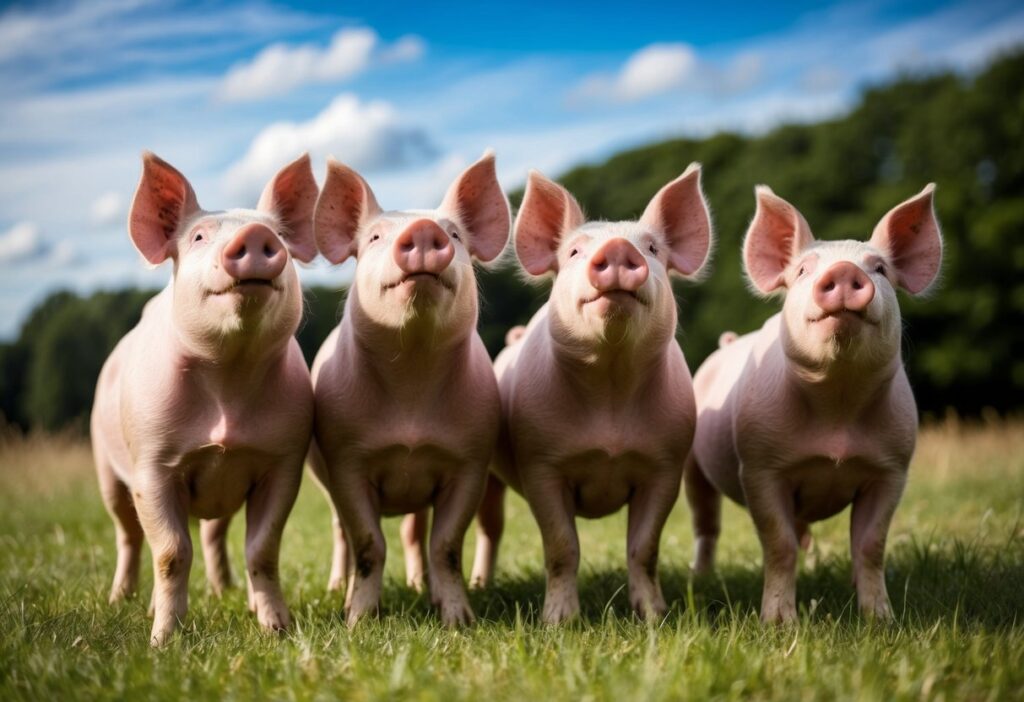
Can Pigs Look Up? Debunking the Myth and Exploring Pig Vision
The question of whether pigs can look up is a common one, often leading to humorous anecdotes and folklore. The simple answer is yes, pigs can look up, although their anatomy does present certain limitations. This article will delve into the truth behind this question, exploring the physiology of pig vision, the reasons for the misconception, and other fascinating facts about how pigs perceive their environment.
Understanding Pig Anatomy and Vision
To understand why the myth persists that pigs can’t look up, it’s essential to examine their anatomy. Pigs have relatively short necks and a stocky build. Their eyes are positioned on the sides of their heads, providing a wide field of vision but limiting their depth perception. This arrangement is common in prey animals, allowing them to detect predators from a broad angle. [See also: Pig Breeds for Small Farms]
However, the position of their eyes, combined with their neck structure, does affect their ability to look directly upwards for extended periods. While pigs can look up, they might not be able to do so comfortably or with a clear, focused view for a prolonged time, especially if the object of their gaze is directly overhead. This limitation is not due to a physical inability to move their necks or eyes upwards but rather a matter of comfort and optimal viewing angle.
The Myth Debunked: How High Can Pigs Actually See?
The notion that pigs can’t look up is largely a myth. Numerous observations and studies have confirmed that pigs are indeed capable of tilting their heads upwards. The degree to which they can look up comfortably varies depending on the individual pig and its physical condition. Younger pigs, with more flexible necks, might find it easier to look up than older, heavier animals.
What contributes to the persistence of this myth? Several factors play a role. Firstly, pigs are naturally ground-dwelling animals. Their behavior is oriented towards foraging, rooting, and exploring the environment at ground level. They are less likely to spend time looking upwards unless prompted by a specific stimulus, such as a potential threat or an interesting sound.
Secondly, the way pigs are typically raised in commercial farming settings can also contribute to the misconception. In confined spaces, pigs may have limited opportunities to look up, reinforcing the idea that they are incapable of doing so. However, pigs in more natural environments, with access to open fields and varied landscapes, demonstrate their ability to look upwards more frequently.
Factors Influencing Pig Vision and Behavior
Several factors influence how pigs use their vision and interact with their surroundings:
- Environment: Pigs in stimulating environments are more likely to exhibit a wider range of visual behaviors, including looking upwards to investigate novel objects or sounds.
- Age and Health: Younger, healthier pigs tend to have greater flexibility and range of motion, making it easier for them to look up.
- Breed: While there is no specific breed known for superior upward vision, individual variations exist within breeds.
- Training and Socialization: Pigs that are trained or socialized to interact with humans or other animals may be more inclined to look up in response to cues or stimuli.
Why Does the Myth Matter? Animal Welfare and Perception
While the question of whether pigs can look up might seem trivial, it has implications for animal welfare and how we perceive these intelligent creatures. Perpetuating myths can lead to a misunderstanding of their capabilities and needs. Recognizing that pigs can look up, and that their vision is an important part of their sensory experience, encourages a more holistic approach to their care.
Providing pigs with environments that allow them to express their natural behaviors, including visual exploration, is crucial for their well-being. This includes ensuring they have access to open spaces, varied terrain, and opportunities to interact with their surroundings in meaningful ways. [See also: Enriching Pig Environments]
Pig Vision Beyond the Myth: Other Interesting Facts
Beyond the ability to look up, pig vision has several other interesting characteristics:
- Color Vision: Pigs are believed to have dichromatic vision, meaning they can see some colors but not as vividly as humans. They are thought to perceive blues and greens more readily than reds.
- Depth Perception: Due to the placement of their eyes, pigs have limited depth perception. This can affect their ability to judge distances accurately.
- Sensitivity to Light: Pigs are more sensitive to bright light than humans. Providing them with shaded areas is important for their comfort and well-being.
- Visual Acuity: Pigs have relatively poor visual acuity compared to humans. They rely more on their sense of smell and hearing to navigate their environment.
Conclusion: Appreciating the Complexities of Pig Vision
In conclusion, the myth that pigs can’t look up is simply untrue. While their anatomy might present some limitations, pigs are indeed capable of looking upwards. Understanding the nuances of pig vision, including their color perception, depth perception, and sensitivity to light, is essential for providing them with optimal care and appreciating their unique sensory experience. By debunking this myth, we can foster a more accurate and compassionate understanding of these intelligent and fascinating animals. The next time you see a pig, remember that they can, indeed, look up and see the world around them, even the sky above. Pigs can look up, and they deserve to be seen and understood in all their complexity. The assertion that pigs can look up is therefore validated through observation and scientific understanding of their anatomy. So, yes, pigs can look up!
